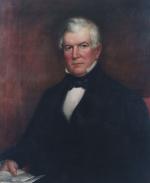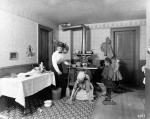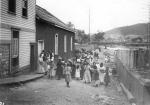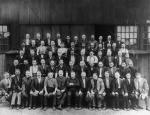Chapter 2: Iron Plantations, and Their Masters and Workers, 1716-1840
Located in rural areas near iron ore deposits, forests for fuel, and streams for water power, iron "plantations" were the centers of iron manufacturing before 1840. To attract workers to these rural locations and support production, ironmasters built sprawling physical plants, which typically had a furnace or forge, houses for workers, an ironmaster's mansion, a charcoal house for storage, store, grist mill, sawmill, and blacksmith shop. Ironmasters also acquired vast acreage, with farms to feed workers and draft animals, forests, and iron ore deposits. Iron plantations were among the largest manufacturing complexes in the nation before 1850. They were also social and labor-management systems, entwining masters and workers in complex relationships.
Ironmasters, like Roland Curtin at Eagle Ironworks, often lived among and interacted frequently with their employees. They relied on workers to labor steadily and produce quality products. They also usually held themselves responsible for their workers' welfare. Typically, they provided workers' housing and stores; sometimes they built churches and schools. When furnaces and forges shut down, ironmasters frequently found work elsewhere on plantations so workers could continue earning livelihoods.
In the paternalistic world of the Pennsylvania iron plantation, ironmasters also demanded obedience and deference. They hired and fired workers and assigned work on plantations. Although some ironmasters sold liquor at their stores, they also encouraged steady, sober work through fines and written agreements. Churches and schools that ironmasters sponsored also taught lessons in industriousness and deference. In addition, ironmasters displayed their superior social status in mansions or "big houses" that were obviously superior to workers' houses.
To build and successfully run an iron works in a constantly fluctuating economy, ironmasters needed considerable funds, expertise, and managerial talent. Before 1840 the great majority of ironmasters formed partnerships to generate capital and spread liability among several partners. They often relied on partnerships with relatives, friends, and previous business associates. Thomas Potts and his son John, who established the largest ironmaking empire in colonial America, were masters of partnering with relatives to buy and build ironworks. Many ironmasters were also merchants who diversified their holdings and risks by branching into iron manufacturing. Some ironmasters rose through the ranks to own and operate larger ironworks.
Thomas Potts and his son John, who established the largest ironmaking empire in colonial America, were masters of partnering with relatives to buy and build ironworks. Many ironmasters were also merchants who diversified their holdings and risks by branching into iron manufacturing. Some ironmasters rose through the ranks to own and operate larger ironworks.  Thomas Rutter, one of Pennsylvania's first ironmasters, started as a blacksmith, opened a bloomery forge and then built a charcoal furnace and refinery forge.
Thomas Rutter, one of Pennsylvania's first ironmasters, started as a blacksmith, opened a bloomery forge and then built a charcoal furnace and refinery forge.
Iron plantations required workers with a broad rrange of skills. Founders kept the furnace in blast, molders cast iron into various products, and colliers smoldered wood to make charcoal these were the most highly skilled workers. Woodcutters and teamsters were much less skilled. Wages reflected this hierarchy of skills, although employees frequently received much of their pay in goods since money was in short supply in a cash-poor economy. Men predominated in the workforce; women supported their families by boarding employees, working on plantation farms, and providing food, sewing, and laundry for others. Children also worked, in less skilled jobs, as ore loaders or farm laborers.
Workers had varied views of their employers. Skilled workers, such as founders or molders, often developed more autonomy than unskilled workers, particularly since skilled workers were often in short supply and not easily replaced. Some were quite devoted, working for the same ironmaster for many years, seeking the ironmaster's advice, even naming sons after their employer. About 30 percent of workers at Cornwall Furnace and Pine Grove Furnace between 1810 and 1830 stayed at least five years.
Cornwall Furnace and Pine Grove Furnace between 1810 and 1830 stayed at least five years.
Other workers defied plantation masters in various ways. They missed work, drank heavily, and performed work negligently. For example, the timekeeper at Birdsboro Forge noted on July 3, 1810, that George Horn, a forgeman, "threw his fire down last Saturday went off drinking." Some discontented workers left the job and never came back. Employees also asked for better pay from an ironmaster, or went to another iron plantation in search of higher pay. In 1838, workers at one of went on strike for higher wages.
Workers were sometimes contentious with one another, breaking agreements or suing for debts and costs, but they also cooperated extensively with each other to help ensure others' welfare. At Hopewell Village they circulated a "subscription paper," pledging to contribute money for a fellow employee in need. They also took time off to help each other. In 1805 Peter Cox and John Boyers took off one half day, losing pay, to go "to John Hart's choping in the Afternoon." In 1819, John Anderson paid for "one quarter of flour for Widow Adams." Without husbands, widows were often hard pressed to make ends meet. Hopewell Village workers also paid each other for goods, such as clothing, shoes, or furniture that fellow employees made.
While ironmasters risked their investments, workers proffered their bodies, performing dirty, arduous, or dangerous work. By 1775, more than 2,000 workers, about 1 percent of the Commonwealth's population, labored in the iron industry. Employees were a diverse lot. Early skilled workers were often immigrants from England or Wales, which had a substantial iron industry. Unskilled workers frequently left local farms or nearby towns. Other unskilled workers were immigrants from Britain and Germany. Speaking a different language than the dominant English, German immigrants and ironmasters brought their Old World culture to Pennsylvania. Ironmaster Daniel Udree, for example, dealt "with his workmen as is customary in Germany; that is, he furnished them with necessaries on account." He stopped this practice after many of his immigrant workers "made use of the opportunity to run up their accounts."
Ironmasters also used slaves and indentured servants on their plantations. Indentured servants typically hauled ore from banks to furnaces and plowed farmland. Bound servants often fled plantations, and soon after the American Revolution indentured servitude fell into disuse. Slaves were a minority of workers on iron plantations; nevertheless, ironmasters were among the largest slave owners in rural Pennsylvania. The four largest slave owners in Berks County in 1780 were all ironmasters, who owned fifty-seven of the 119 slaves in the county. Ironmasters at Hopewell Village in some ways treated slaves equitably with whites, giving hired slaves the same wages as whites and housing them among white neighbors on the plantation. However, ironmasters at other plantations did not pay wages to slaves, and all slaves were subject to being sold as property.
Slaves had complex relationships with ironmasters and each other. Small numbers of slaves worked at iron plantations, so slaves usually had few others to turn to for mutual support. For the African-born, their different languages and unfamiliarity with English or German hampered communication. Slavery was a lonely sentence for most blacks, and many resisted their captivity. Cuff Dix, a slave at Birdsboro Forge, fled repeatedly. In 1775 Bird complained that Dix "has often run away, changed his name, denied that [Bird] was his master, and been confined in several goals in this province." When slaves fled, they often tried to remake their identities and support themselves. When a slave named "Joe" fled Charming Forge, he took a gun, tomahawk, and pair of boots. Henry Smith captured Joe, returned him to Charming Forge in a neck collar, and collected a large cash reward.
 Iron plantations flourished during the eighteenth and early nineteenth centuries, and some persisted even into the early twentieth century. However, iron plantations peaked during the 1830s. New types of production complexes, including anthracite-coal and bituminous-coke furnaces and large rolling mills came to dominate the industry and replace iron plantations after 1840.
Iron plantations flourished during the eighteenth and early nineteenth centuries, and some persisted even into the early twentieth century. However, iron plantations peaked during the 1830s. New types of production complexes, including anthracite-coal and bituminous-coke furnaces and large rolling mills came to dominate the industry and replace iron plantations after 1840.
Ironmasters, like Roland Curtin at Eagle Ironworks, often lived among and interacted frequently with their employees. They relied on workers to labor steadily and produce quality products. They also usually held themselves responsible for their workers' welfare. Typically, they provided workers' housing and stores; sometimes they built churches and schools. When furnaces and forges shut down, ironmasters frequently found work elsewhere on plantations so workers could continue earning livelihoods.
In the paternalistic world of the Pennsylvania iron plantation, ironmasters also demanded obedience and deference. They hired and fired workers and assigned work on plantations. Although some ironmasters sold liquor at their stores, they also encouraged steady, sober work through fines and written agreements. Churches and schools that ironmasters sponsored also taught lessons in industriousness and deference. In addition, ironmasters displayed their superior social status in mansions or "big houses" that were obviously superior to workers' houses.
To build and successfully run an iron works in a constantly fluctuating economy, ironmasters needed considerable funds, expertise, and managerial talent. Before 1840 the great majority of ironmasters formed partnerships to generate capital and spread liability among several partners. They often relied on partnerships with relatives, friends, and previous business associates.
Iron plantations required workers with a broad rrange of skills. Founders kept the furnace in blast, molders cast iron into various products, and colliers smoldered wood to make charcoal these were the most highly skilled workers. Woodcutters and teamsters were much less skilled. Wages reflected this hierarchy of skills, although employees frequently received much of their pay in goods since money was in short supply in a cash-poor economy. Men predominated in the workforce; women supported their families by boarding employees, working on plantation farms, and providing food, sewing, and laundry for others. Children also worked, in less skilled jobs, as ore loaders or farm laborers.
Workers had varied views of their employers. Skilled workers, such as founders or molders, often developed more autonomy than unskilled workers, particularly since skilled workers were often in short supply and not easily replaced. Some were quite devoted, working for the same ironmaster for many years, seeking the ironmaster's advice, even naming sons after their employer. About 30 percent of workers at
Other workers defied plantation masters in various ways. They missed work, drank heavily, and performed work negligently. For example, the timekeeper at Birdsboro Forge noted on July 3, 1810, that George Horn, a forgeman, "threw his fire down last Saturday went off drinking." Some discontented workers left the job and never came back. Employees also asked for better pay from an ironmaster, or went to another iron plantation in search of higher pay. In 1838, workers at one of went on strike for higher wages.
Workers were sometimes contentious with one another, breaking agreements or suing for debts and costs, but they also cooperated extensively with each other to help ensure others' welfare. At Hopewell Village they circulated a "subscription paper," pledging to contribute money for a fellow employee in need. They also took time off to help each other. In 1805 Peter Cox and John Boyers took off one half day, losing pay, to go "to John Hart's choping in the Afternoon." In 1819, John Anderson paid for "one quarter of flour for Widow Adams." Without husbands, widows were often hard pressed to make ends meet. Hopewell Village workers also paid each other for goods, such as clothing, shoes, or furniture that fellow employees made.
While ironmasters risked their investments, workers proffered their bodies, performing dirty, arduous, or dangerous work. By 1775, more than 2,000 workers, about 1 percent of the Commonwealth's population, labored in the iron industry. Employees were a diverse lot. Early skilled workers were often immigrants from England or Wales, which had a substantial iron industry. Unskilled workers frequently left local farms or nearby towns. Other unskilled workers were immigrants from Britain and Germany. Speaking a different language than the dominant English, German immigrants and ironmasters brought their Old World culture to Pennsylvania. Ironmaster Daniel Udree, for example, dealt "with his workmen as is customary in Germany; that is, he furnished them with necessaries on account." He stopped this practice after many of his immigrant workers "made use of the opportunity to run up their accounts."
Ironmasters also used slaves and indentured servants on their plantations. Indentured servants typically hauled ore from banks to furnaces and plowed farmland. Bound servants often fled plantations, and soon after the American Revolution indentured servitude fell into disuse. Slaves were a minority of workers on iron plantations; nevertheless, ironmasters were among the largest slave owners in rural Pennsylvania. The four largest slave owners in Berks County in 1780 were all ironmasters, who owned fifty-seven of the 119 slaves in the county. Ironmasters at Hopewell Village in some ways treated slaves equitably with whites, giving hired slaves the same wages as whites and housing them among white neighbors on the plantation. However, ironmasters at other plantations did not pay wages to slaves, and all slaves were subject to being sold as property.
Slaves had complex relationships with ironmasters and each other. Small numbers of slaves worked at iron plantations, so slaves usually had few others to turn to for mutual support. For the African-born, their different languages and unfamiliarity with English or German hampered communication. Slavery was a lonely sentence for most blacks, and many resisted their captivity. Cuff Dix, a slave at Birdsboro Forge, fled repeatedly. In 1775 Bird complained that Dix "has often run away, changed his name, denied that [Bird] was his master, and been confined in several goals in this province." When slaves fled, they often tried to remake their identities and support themselves. When a slave named "Joe" fled Charming Forge, he took a gun, tomahawk, and pair of boots. Henry Smith captured Joe, returned him to Charming Forge in a neck collar, and collected a large cash reward.

















